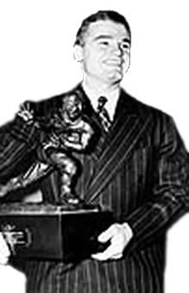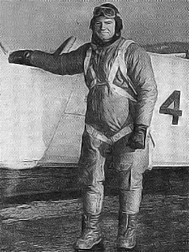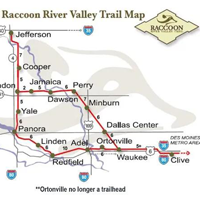Nile Kinnick Museum Article
We’ve had several requests to re-run the March Newsletter article we ran on Nile Kinnick. With the passing of June and the anniversary of his death, it seems only fitting to honor one of Adel’s native sons. We hope that you enjoy. (July 17, 2009)
– Courtesy: Julie Bailey – Adel Partners Chamber of Commerce.
 The community of Adel is well-known for its brick streets, beautiful County Courthouse, and the Sweet Corn Festival. Adel is also the hometown of Nile Clarke Kinnick Jr., the winner of the 1939 Heisman Trophy for the University of Iowa. The football stadium at the University of Iowa is named in his honor.
The community of Adel is well-known for its brick streets, beautiful County Courthouse, and the Sweet Corn Festival. Adel is also the hometown of Nile Clarke Kinnick Jr., the winner of the 1939 Heisman Trophy for the University of Iowa. The football stadium at the University of Iowa is named in his honor.
The Adel Historical Museum and Adel Partners Chamber of Commerce are pursuing a vision for a Nile Kinnick Wing of the current historical museum in Adel.
In April 2009, a few select pieces of Nile Kinnick memorabilia will be available through an online auction. The Adel Historical Museum is fundraising in an effort to purchase all or part of this memorabilia and bring it home to Kinnick’s community where he spent his childhood. This would also complement the Kinnick items currently held in the Adel community and support the beginnings of a museum addition to highlight Kinnick’s life.
Nile Kinnick was born on July 9, 1918, in Adel, Iowa, the grandson of a governor. His grandfather, George Clarke was Governor of Iowa from 1913 to 1917 and practiced law in Adel. Nile was a star athlete in football and basketball at Adel High School before the family moved to Omaha, Neb., after his junior year.

In 1939, Irl Tubbs was out as coach, Eddie Anderson was in, and the path was cleared for Kinnick’s senior season at the University of Iowa. A halfback who was the team’s main passer, Kinnick threw for 638 yards and 11 touchdowns as well as rushing for 374 yards on 106 carries (3.5-yard average). He also made 11-of-17 dropkick conversion attempts and scored 41 points. By passing, running or kicking, Kinnick was directly involved in 107 of Iowa’s 130 points that season. He also made eight interceptions. He finished his career at Iowa with 1,674 yards rushing, 18 interceptions (an Iowa record that lasted half a century) and an average of 39.9 yards per punt.
The Chicago Tribune’s version of the Big Ten MVP award preceded Kinnick’s winning the Walter Camp and Maxwell awards, further validating the prevailing opinion he was the nation’s best football player. On Dec, 6, 1939, his acceptance of the Heisman Trophy became a seminal moment – both in athletics and in oratory. Kinnick’s celebrity became so strong, he was named 1939’s top male athlete in the country by the Associated Press. The honor was particularly noteworthy considering his competition included Joe DiMaggio, Joe Louis and Byron Nelson.
 In August 1941, Kinnick decided war was imminent and joined the Naval Air Corps Reserve. While waiting to be called to active duty, he was an assistant coach for Iowa that fall. On December 4, three days before Pearl Harbor, he reported for duty. On June 2, 1943, Kinnick was flying a training mission from the U.S.S. Lexington off the coast of Venezuela when he experienced engine problems. Rescue parties searched for several hours, but Kinnick’s body was never found amid the oil slick. Nile Kinnick was 24.
In August 1941, Kinnick decided war was imminent and joined the Naval Air Corps Reserve. While waiting to be called to active duty, he was an assistant coach for Iowa that fall. On December 4, three days before Pearl Harbor, he reported for duty. On June 2, 1943, Kinnick was flying a training mission from the U.S.S. Lexington off the coast of Venezuela when he experienced engine problems. Rescue parties searched for several hours, but Kinnick’s body was never found amid the oil slick. Nile Kinnick was 24.
“A Nile Kinnick wing of the Adel Historical Museum would be a tremendous asset to the Adel community and the state of Iowa.” says Julie Bailey, Program Director for the Adel Chamber of Commerce. “Kinnick’s legacy is so large and it only seems fitting to honor him in the town he loved so much.” she continued.
Anyone interested in learning more about the Kinnick museum planning process or is interested in making a tax deductible contribution toward the purchase of the memorabilia to begin the new museum effort can contact Adel Partners Chamber of Commerce via email at chamber@AdelPartners.Org or phone 515-993-5472.






